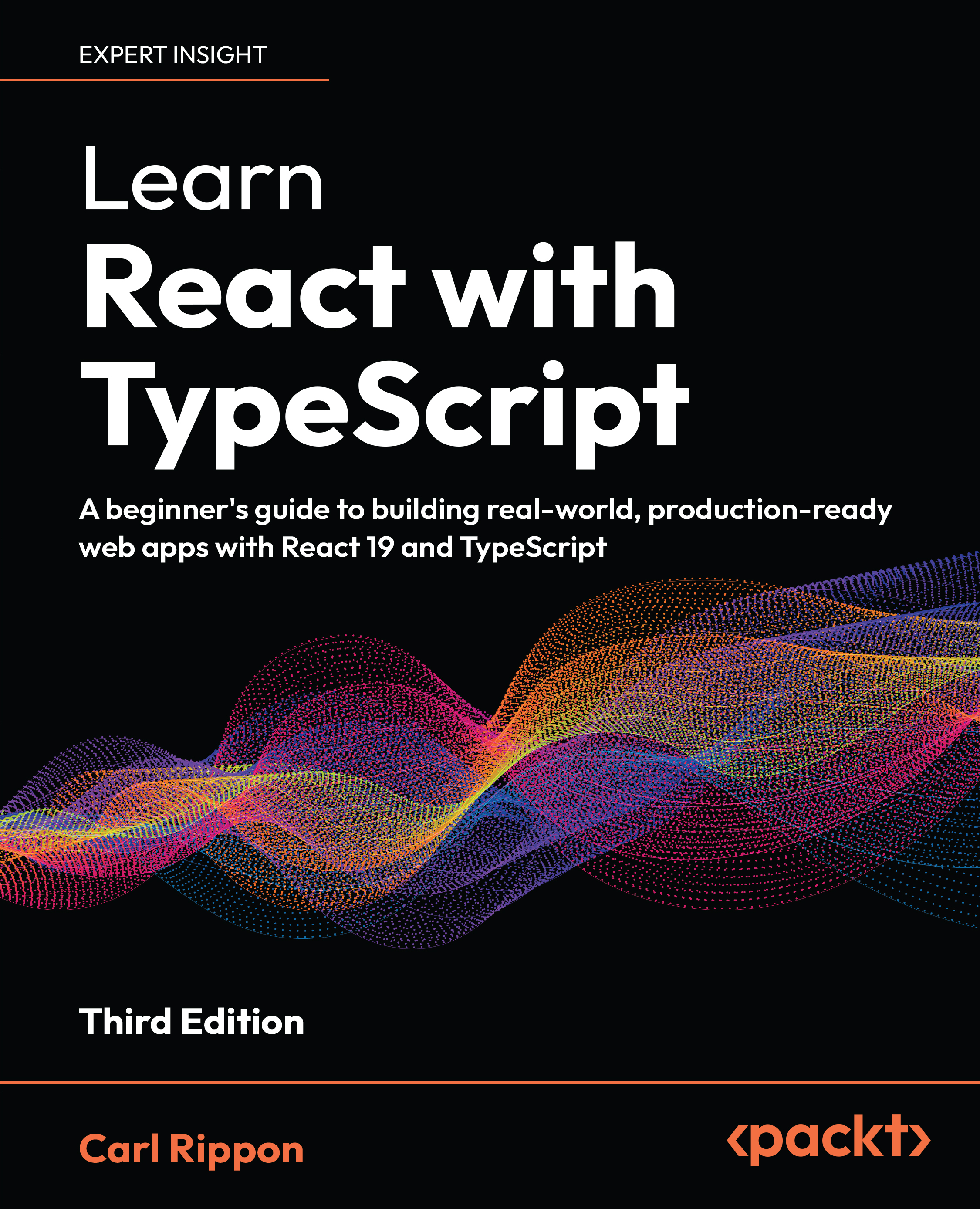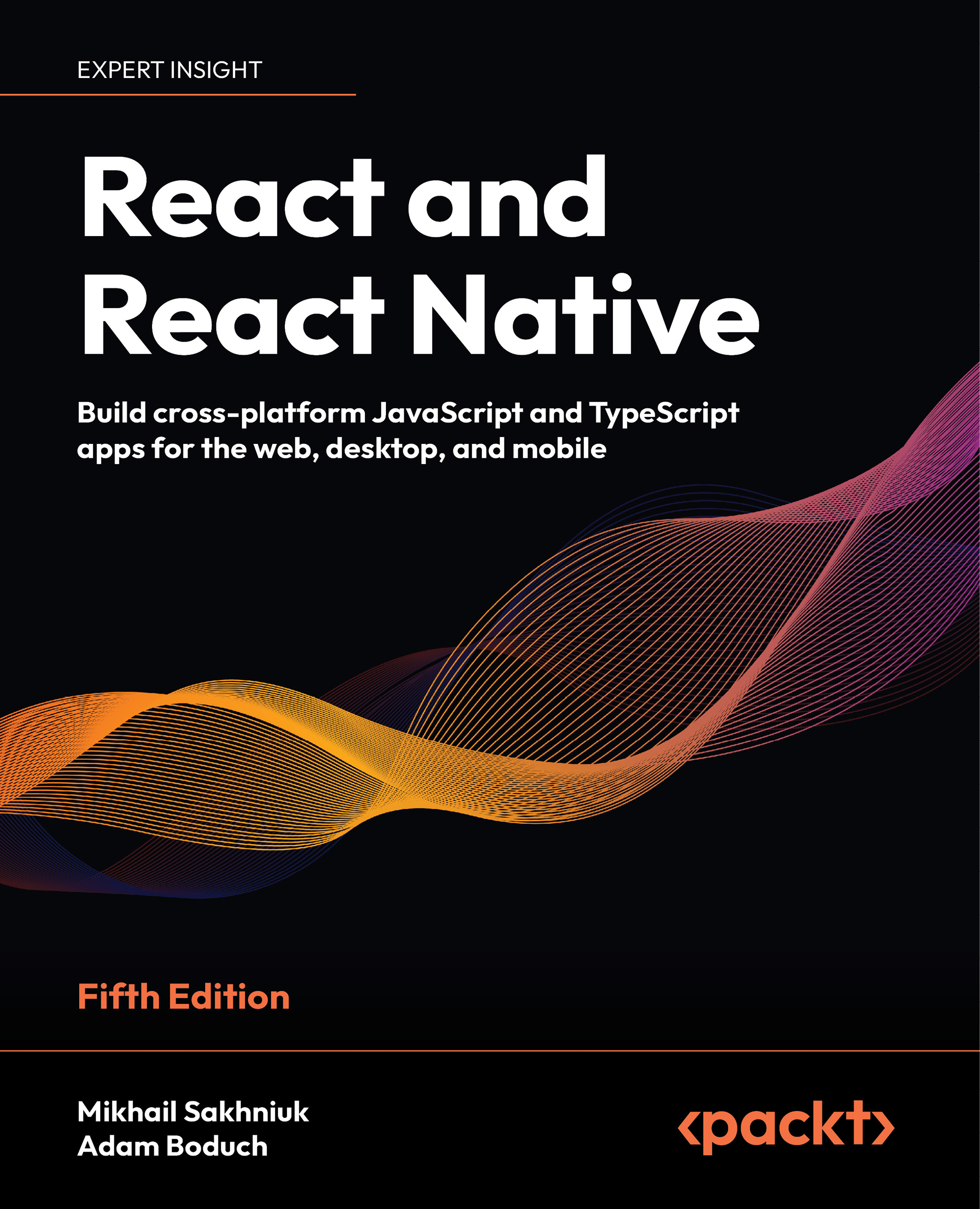TypeScript language features
Now that you have learned about the purpose of TypeScript, it's time to get our hands dirty and start writing some code.
Before you can start learning how to use some of the basic TypeScript building blocks, you will need to set up your development environment. The easiest and fastest way to start writing some TypeScript code is to use the online editor, available on the official TypeScript website at https://www.typescriptlang.org/play/index.html:
The preceding screenshot shows the appearance of the TypeScript playground. If you visit the playground, you will be able to use the text editor on the left-hand side of the screen to write TypeScript code. The code will then be automatically compiled into JavaScript. The output code will be inserted in the text editor located on the right-hand side of the screen. If your TypeScript code is invalid, the JavaScript code on the right-hand side will not be updated.
Alternatively, if you prefer to be able to work offline, you can download and install the TypeScript compiler. If you work with a Visual Studio version older than Visual Studio 2015, you will need to download the official TypeScript extension from https://marketplace.visualstudio.com/. If you are working with a version of Visual Studio released after the 2015 version (or Visual Studio Code), you will not need to install the extension, as these versions includes TypeScript support by default.
You can also use TypeScript from the command-line interface by downloading it as an npm module. Don't worry if you are not familiar with npm. For now, you only need to know that it stands for node package manager and is the default Node.js package manager. Node.js is an open source, cross-platform JavaScript runtime environment for executing JavaScript code server-side. To be able to use npm, you will need to install Node.js in your development environment. You will be able to find the Node.js installation files on the official website at https://nodejs.org/.
Once you have installed Node.js in your development environment, you will be able to run the following command in a console or Terminal:
npm install -g typescript
Note
Unix-based operating systems may require the use of the sudo command when installing global (-g) npm packages. The sudo command will prompt the user credentials and install the package using administrative privileges:sudo npm install -g typescript
Create a new file named test.ts, and add the following code to it:
let myNumberVariable: number = 1;
console.log(myNumberVariable);
Save the file into a directory of your choice and open a command-line interface. Navigate to the directory in which you saved the file and execute the following command:
tsc test.ts
If everything goes well, you will find a file named test.js in the same directory in which the test.ts file is located. Now you know how to compile your TypeScript code into JavaScript code.
You can execute the output JavaScript code using Node.js:
node test.js
Now that we know how to compile and execute TypeScript source code, we can start learning about some of the TypeScript features.
Note
You will be able to learn more about editors, compiler options, and other TypeScript tools in Chapter 9,Automating Your Development Workflow.
As we have already learned, TypeScript is a typed superset of JavaScript. TypeScript added a static type system and optional static type annotations to JavaScript to transform it into a strongly-typed programming language.
TypeScript's type analysis occurs entirely at compile time and adds no runtime overhead to program execution.
Type inference and optional static type annotations
The TypeScript language service is great at automatically detecting the type of a variable. However, there are certain cases where it is not able to automatically detect a type.
When the type inference system is not able to identify the type of a variable, it uses a type known as the any type. The any type is a value that represents all the existing types, and as a result, it is too flexible and unable to detect most errors, which is not a problem because TypeScript allows us to explicitly declare the type of a variable using what is known as optional static type annotations.
The optional static type annotations are used as constraints on program entities such as functions, variables, and properties so that compilers and development tools can offer better verification and assistance (such as IntelliSense) during software development.
Strong typing allows programmers to express their intentions in their code, both to themselves and to others in the development team.
For a variable, a type notation comes preceded by a colon after the name of a variable:
let counter; // unknown (any) type
let counter = 0; // number (inferred)
let counter: number; // number
let counter: number = 0; // number
Note
We have used the let keyword instead of the var keyword. The let keyword is a newer JavaScript construct that TypeScript makes available. We'll discuss the details later, but some common problems in JavaScript can be solved by using let, so, you should use let instead of var whenever possible.
As you can see, we declare the type of a variable after its name; this style of type notation is based on type theory and helps to reinforce the idea of types being optional.
When no type annotations are available, TypeScript will try to guess the type of the variable by examining the assigned values. For example, in the second line, in the preceding code snippet, we can see that the variable counter has been identified as a numeric variable, because its value is a numeric value. There is a process known as type inference that can automatically detect and assign a type to a variable. The any type is used as the type of a variable when the type inference system is not able to detect its type.
Please note that the companion source code might be slightly different from the code presented during the chapters. The companion source code uses namespaces to isolate each demo from all the other demos and sometimes appends numbers to the name of the variables to prevent naming conflicts. For example, the preceding code is included in the companion source code as follows:
namespace type_inference_demo {
let counter1; // unknown (any) type
let counter2 = 0; // number (inferred)
let counter3: number; // number
let counter4: number = 0; // number
} Note
You will be able to learn more about the TypeScript type system in Chapter 2, Working with Types.
Variables, basic types, and operators
The basic types are boolean, number, string, array, tuple, Object, object, null, undefined, {}, void, and enumerations. Let's learn about each of these basic types:
In TypeScript and JavaScript, undefined is a property in the global scope that is assigned as a value to variables that have been declared but have not yet been initialized. The value null is a literal (not a property of the global object) and it can be assigned to a variable as a representation of no value:
let testVar; // variable is declared but not initialized
consoe.log(testVar); // shows undefined
console.log(typeof testVar); // shows undefined
let testVar = null; // variable is declared, and null is assigned as its value
cosole.log(testVar); // shows null
console.log(typeof testVar); // shows object
Variable scope (var, let, and const)
When we declare a variable in TypeScript, we can use the var, let, or const keywords:
var myNumber: number = 1;
let isValid: boolean = true;
const apiKey: string = "0E5CE8BD-6341-4CC2-904D-C4A94ACD276E";
Variables declared with var are scoped to the nearest function block (or global, if outside a function block).
Variables declared with let are scoped to the nearest enclosing block (or global, if outside any block), which can be smaller than a function block.
The const keyword creates a constant that can be global or local to the block in which it is declared. This means that constants are block-scoped.
Note
You will learn more about scopes in Chapter 6, Understanding the Runtime.
TypeScript supports the following arithmetic operators. We must assume that variable A holds 10 and variable B holds 20 to understand the following examples:
TypeScript supports the following comparison operators. To understand the examples, you must assume that variable A holds 10 as value and variable B holds 20 as value:
TypeScript supports the following logical operators. To understand the examples, you must assume that variable A holds 10 and variable B holds 20:
TypeScript supports the following bitwise operators. To understand the examples, you must assume that variable A holds 2 as value and variable B holds 3 as value:
Note
One of the main reasons to use bitwise operators in languages such as C++, Java, or C# is that they're extremely fast. However, bitwise operators are often considered not that efficient in TypeScript and JavaScript. The bitwise operators are less efficient in JavaScript, because it is necessary to cast from floating-point representation (how JavaScript stores all of its numbers) to a 32-bit integer to perform the bit manipulation and back.
TypeScript supports the following assignment operators:
The spread operator can be used to initialize arrays and objects from another array or object:
let originalArr1 = [ 1, 2, 3];
let originalArr2 = [ 4, 5, 6];
let copyArr = [...originalArr1];
let mergedArr = [...originalArr1, ...originalArr2];
let newObjArr = [...originalArr1, 7, 8];
The preceding code snippet showcases the usage of the spread operator with arrays, while the following code snippet showcases its usage with object literals:
let originalObj1 = {a: 1, b: 2, c: 3};
let originalObj2 = {d: 4, e: 5, f: 6};
let copyObj = {...originalObj1};
let mergedObj = {...originalObj1, ...originalObj2};
let newObjObj = {... originalObj1, g: 7, h: 8}; The spread operator can also be used to expand to an expression into multiple arguments (in function calls), but we will skip that use case for now.
Note
We will learn more about the spread operator in Chapter 3, Working with Functions and Chapter 4, Object-Oriented Programming with TypeScript.
This section describes the decision-making statements, the looping statements, and the branching statements supported by the TypeScript programming language.
The single-selection structure (if)
The following code snippet declares a variable of type boolean and name isValid. Then, an if statement will check whether the value of isValid is equal to true. If the statement turns out to be true, the Is valid! message will be displayed on the screen:
let isValid: boolean = true;
if (isValid) {
console.log("is valid!");
} The double-selection structure (if...else)
The following code snippet declares a variable of type boolean and name isValid. Then, an if statement will check whether the value of isValid is equal to true. If the statement turns out to be true, the message Is valid! will be displayed on the screen. On the other hand, if the statement turns out to be false, the message Is NOT valid! will be displayed on the screen:
let isValid: boolean = true;
if (isValid) {
console.log("Is valid!");
} else {
console.log("Is NOT valid!");
} The inline ternary operator (?)
The inline ternary operator is just an alternative way of declaring a double-selection structure:
let isValid: boolean = true;
let message = isValid ? "Is valid!" : "Is NOT valid!";
console.log(message);
The preceding code snippet declares a variable of type boolean and name isValid. Then, it checks whether the variable or expression on the left-hand side of the operator ? is equal to true.
If the statement turns out to be true, the expression on the left-hand side of the character will be executed and the message Is valid! will be assigned to the message variable.
On the other hand, if the statement turns out to be false, the expression on the right-hand side of the operator will be executed and the message, Is NOT valid! will be assigned to the message variable.
Finally, the value of the message variable is displayed on the screen.
The multiple-selection structure (switch)
The switch statement evaluates an expression, matches the expression's value to a case clause, and executes statements associated with that case. Switch statements and enumerations are often used together to improve the readability of the code.
In the following example, we declare a function that takes an enumeration named AlertLevel.
Note
You will learn more about enumerations in Chapter 2, Working with Types.
Inside the function, we will generate an array of strings to store email addresses and execute a switch structure. Each of the options of the enumeration is a case in the switch structure:
enum AlertLevel{
info,
warning,
error
}
function getAlertSubscribers(level: AlertLevel){
let emails = new Array<string>();
switch(level){
case AlertLevel.info:
emails.push("[email protected]");
break;
case AlertLevel.warning:
emails.push("[email protected]");
emails.push("[email protected]");
break;
case AlertLevel.error:
emails.push("[email protected]");
emails.push("[email protected]");
emails.push("[email protected]");
break;
default:
throw new Error("Invalid argument!");
}
return emails;
}
getAlertSubscribers(AlertLevel.info); // ["[email protected]"]
getAlertSubscribers(AlertLevel.warning); //
["[email protected]", "[email protected]"]The value of the level variable is tested against all the cases in the switch. If the variable matches one of the cases, the statement associated with that case is executed. Once the case statement has been executed, the variable is tested against the next case.
Once the execution of the statement associated with a matching case is finalized, the next case will be evaluated. If the break keyword is present, the program will not continue the execution of the following case statement.
If no matching case clause is found, the program looks for the optional default clause, and if found, it transfers control to that clause and executes the associated statements.
If no default clause is found, the program continues execution at the statement following the end of switch. By convention, the default clause is the last clause, but it does not have to be so.
The expression is tested at the top of the loop (while)
The while expression is used to repeat an operation while a certain requirement is satisfied. For example, the following code snippet declares a numeric variable i. If the requirement (the value of i is less than 5) is satisfied, an operation takes place (increase the value of i by one and display its value in the browser console). Once the operation has completed, the accomplishment of the requirement will be checked again:
let i: number = 0;
while (i < 5) {
i += 1;
console.log(i);
} In a while expression, the operation will take place only if the requirement is satisfied.
The expression is tested at the bottom of the loop (do...while)
The do...while expression can be used to repeat an instruction until a certain requirement is not satisfied. For example, the following code snippet declares a numeric variable i and repeats an operation (increase the value of i by one and display its value in the browser console) for as long as the requirement (the value of i is less than five) is satisfied:
let i: number = 0;
do {
i += 1;
console.log(i);
} while (i < 5); Unlike the while loop, the do...while expression will execute at least once, regardless of the tested expression, as the operation will take place before checking whether a certain requirement is satisfied or not.
Iterate on each object's properties (for...in)
The for...in statement by itself is not a bad practice; however, it can be misused, for example, to iterate over arrays or array-like objects. The purpose of the for...in statement is to enumerate over object properties:
let obj: any = { a: 1, b: 2, c: 3 };
for (let key in obj) {
if (obj.hasOwnProperty(key)) {
console.log(key + " = " + obj[key]);
}
}
// Output:
// "a = 1"
// "b = 2"
// "c = 3" The following code snippet will go up in the prototype chain, also enumerating the inherited properties. The for...in statement iterates the entire prototype chain, also enumerating the inherited properties. When you want to enumerate only the object's properties that aren't inherited, you can use the hasOwnProperty method.
Iterate values in an iterable (for...of)
In JavaScript, some built-in types are built-in iterables with a default iteration behavior. To be an iterable, an object must implement the @@iterator method, meaning that the object (or one of the objects in its prototype chain) must have a property with a @@iterator key, which is available via constant Symbol.iterator.
The for...of statement creates a loop iterating over iterable objects (including array, map, set, string, arguments object, and so on):
let iterable = [10, 20, 30];
for (let value of iterable) {
value += 1;
console.log(value);
} Note
You will learn more about iterables in Chapter 4, Object-Oriented Programming with TypeScript.
Counter-controlled repetition (for)
The for statement creates a loop that consists of three optional expressions, enclosed in parentheses and separated by semicolons, followed by a statement or a set of statements executed in the loop:
for (let i: number = 0; i < 9; i++) {
console.log(i);
} The preceding code snippet contains a for statement. It starts by declaring the variable i and initializing it to 0. It checks whether i is less than 9, performs the two succeeding statements, and increments i by one after each pass through the loop.
Just as in JavaScript, TypeScript functions can be created either as a named function or as an anonymous function, which allows us to choose the most appropriate approach for an application, whether we are building a list of functions in an API or a one-off function to hand over to another function:
// named function
function greet(name?: string): string {
if(name){
return "Hi! " + name;
} else {
return "Hi!";
}
}
// anonymous function
let greet = function(name?: string): string {
if (name) {
return "Hi! " + name;
} else {
return "Hi!";
}
} As we can see in the preceding code snippet, in TypeScript, we can add types to each of the parameters and then to the function itself to add a return type. TypeScript can infer the return type by looking at the return statements, so we can also optionally leave this off in many cases.
There is an alternative syntax for functions that use the => operator after the return type and don't use the function keyword:
let greet = (name: string): string => {
if(name){
return "Hi! " + name;
}
else
{
return "Hi";
}
}; Now that we have learned about this alternative syntax, we can return to the previous example, in which we were assigning an anonymous function to the greet variable. We can now add the type annotations to the greet variable to match the anonymous function signature:
let greet: (name: string) => string = function(name: string):
string {
if (name) {
return "Hi! " + name;
} else {
return "Hi!";
}
}; Note
Keep in mind that the arrow function (=>) syntax changes the way the this keyword works when working with classes. We will learn more about this in the upcoming chapters.
Now you know how to add type annotations to force a variable to be a function with a specific signature. The usage of this kind of annotation is really common when we use a callback (functions used as an argument of another function):
function add(
a: number, b: number, callback: (result: number) => void
) {
callback(a + b);
} In the preceding example, we are declaring a function named add that takes two numbers and a callback as a function. The type annotations will force the callback to return void and take a number as its only argument.
Note
We will focus on functions in Chapter 3,Working with Functions.
ECMAScript 6, the next version of JavaScript, adds class-based object-orientation to JavaScript and, since TypeScript includes all the features available in ES6, developers are allowed to use class-based object orientation today, and compile them down to JavaScript that works across all major browsers and platforms, without having to wait for the next version of JavaScript.
Let's take a look at a simple TypeScript class definition example:
class Character {
public fullname: string;
public constructor(firstname: string, lastname: string) {
this.fullname = `${firstname} ${lastname}`;
}
public greet(name?: string) {
if (name) {
return `Hi! ${name}! my name is ${this.fullname}`;
} else {
return `Hi! my name is ${this.fullname}`;
}
}
}
let spark = new Character("Jacob","Keyes");
let msg = spark.greet();
console.log(msg); // "Hi! my name is Jacob Keyes"
let msg1 = spark.greet("Dr. Halsey");
console.log(msg1); // "Hi! Dr. Halsey! my name is Jacob Keyes" In the preceding example, we have declared a new class, Character. This class has three members: a property called fullname, a constructor, and a method greet. When we declare a class in TypeScript, all the methods and properties are public by default. We have used the public keyword to be more explicit; being explicit about the accessibility of the class members is recommended but it is not a requirement.
You'll notice that when we refer to one of the members of the class (from within itself), we prepend the this operator. The this operator denotes that it's a member access. In the last lines, we construct an instance of the Character class using a new operator. This calls into the constructor we defined earlier, creating a new object with the Character shape and running the constructor to initialize it.
TypeScript classes are compiled into JavaScript functions in order to achieve compatibility with ECMAScript 3 and ECMAScript 5.
Note
We will learn more about classes and other object-oriented programming concepts in Chapter 4,Object-Oriented Programming with TypeScript.
In TypeScript, we can use interfaces to ensure that a class follows a particular specification:
interface LoggerInterface{
log(arg: any): void;
}
class Logger implements LoggerInterface {
log (arg: any){
if (typeof console.log === "function") {
console.log(arg);
} else {
console.log(arg);
}
}
} In the preceding example, we have defined an interface LoggerInterface and a class Logger, which implements it. TypeScript will also allow you to use interfaces to declare the type of an object. This can help us to prevent many potential issues, especially when working with object literals:
interface UserInterface {
name: string;
password: string;
}
// Error property password is missing
let user: UserInterface = {
name: ""
}; Note
We will learn more about interfaces and other object-oriented programming concepts in Chapter 4,Object-Oriented Programming with TypeScript.
Namespaces, also known as internal modules, are used to encapsulate features and objects that share a certain relationship. Namespaces will help you to organize your code. To declare a namespace in TypeScript, you will use the namespace and export keywords:
Note
In older versions of TypeScript, the keyword to define an internal module was module instead of namespace.
namespace geometry {
interface VectorInterface {
/* ... */
}
export interface Vector2DInterface {
/* ... */
}
export interface Vector3DInterface {
/* ... */
}
export class Vector2D
implements VectorInterface, Vector2dInterface {
/* ... */
}
export class Vector3D
implements VectorInterface, Vector3DInterface {
/* ... */
}
}
let vector2DInstance: geometry.Vector2DInterface = new
geometry.Vector2D();
let vector3DInstance: geometry.Vector3DInterface = new
geometry.Vector3d(); In the preceding code snippet, we have declared a namespace that contains the classes vector2D and vector3D and the interfaces VectorInterface, Vector2DInterface, and Vector3DInterface. Note that the first interface is missing the keyword export. As a result, the interface VectorInterface will not be accessible from outside the module's scope.
Note
Namespaces are a good way to organize your code; however, they are not the recommended way to organize your code in a TypeScript application. We will not get into more details about this topic for now, but we will learn more about internal and external modules and we'll discuss when each is appropriate and how to use them in Chapter 4, Object-Oriented Programming with TypeScript.
 United States
United States
 Great Britain
Great Britain
 India
India
 Germany
Germany
 France
France
 Canada
Canada
 Russia
Russia
 Spain
Spain
 Brazil
Brazil
 Australia
Australia
 South Africa
South Africa
 Thailand
Thailand
 Ukraine
Ukraine
 Switzerland
Switzerland
 Slovakia
Slovakia
 Luxembourg
Luxembourg
 Hungary
Hungary
 Romania
Romania
 Denmark
Denmark
 Ireland
Ireland
 Estonia
Estonia
 Belgium
Belgium
 Italy
Italy
 Finland
Finland
 Cyprus
Cyprus
 Lithuania
Lithuania
 Latvia
Latvia
 Malta
Malta
 Netherlands
Netherlands
 Portugal
Portugal
 Slovenia
Slovenia
 Sweden
Sweden
 Argentina
Argentina
 Colombia
Colombia
 Ecuador
Ecuador
 Indonesia
Indonesia
 Mexico
Mexico
 New Zealand
New Zealand
 Norway
Norway
 South Korea
South Korea
 Taiwan
Taiwan
 Turkey
Turkey
 Czechia
Czechia
 Austria
Austria
 Greece
Greece
 Isle of Man
Isle of Man
 Bulgaria
Bulgaria
 Japan
Japan
 Philippines
Philippines
 Poland
Poland
 Singapore
Singapore
 Egypt
Egypt
 Chile
Chile
 Malaysia
Malaysia


















